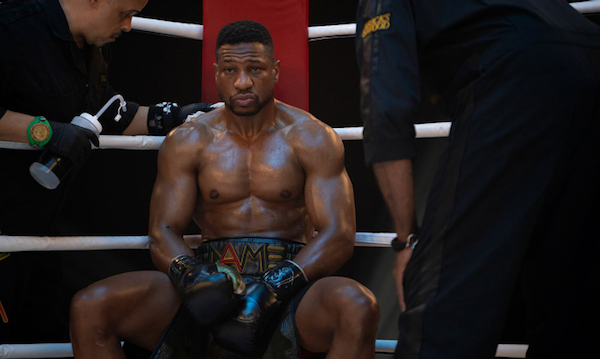Movie review by Greg Carlson
In “Creed III,” the latest installment of the “Rocky” spinoff series, Michael B. Jordan makes his directorial debut with a sturdy piece of franchise storytelling. Jordan also returns to the ring as the title character, his chiseled frame and obligatory training montage (in this one, Adonis tows a small airplane, another other feats) suggesting the kind of superpowers displayed in the Marvel Cinematic Universe – to which Jordan, Tessa Thompson, Jonathan Majors, and Sylvester Stallone also belong. Stallone’s Rocky Balboa, who featured so prominently in the first two “Creed” chapters, does not show up this time. His spirit is respectfully acknowledged, however, and Stallone’s name appears in the credits as a producer.
Following “Creed II,” both Jordan and Stallone responded favorably to the suggestion that pro heavyweight Deontay Wilder could play the son of Mr. T’s James “Clubber” Lang, but the screenplay, credited to Zach Baylin and Keenan Coogler, takes advantage of Stallone’s absence by moving the action to Los Angeles and imagining an altogether different way of exploring how Adonis can be haunted by ghosts from his past. Instead of another go at the child of one of Rocky’s adversaries (Florian Munteanu is briefly back as Ivan Drago’s son), “Creed III” introduces Majors as Damian “Diamond Dame” Anderson, a childhood friend of Adonis paroled after 18 years behind bars.
The addition of Majors to the saga is a masterstroke. The actor seizes another opportunity to demonstrate a deep wellspring of emotional subtleties that both transcend the scripted dialogue and promise greater things to come. Like Jordan, the physical transformation of Majors is a sight to behold, nothing short of a spectacle that invites our gaze. On the heels of his struggling bodybuilder Killian Maddox in “Magazine Dreams” and his menacing future scientist Kang the Conqueror in “Ant-Man and the Wasp: Quantumania,” Majors continues his ascendancy as a formidable screen presence.
The increasingly sophisticated fight choreography, as rendered via the bloody ballet between Majors and Jordan, is the bread and butter of the genre. As both performer and director, Jordan has a genuine knack for the evolution of the sport’s portrayal on the big screen. The hardcore anime fan has pointed out the deep-cut influence of “Naruto: Shippuden” on both a specific punch and on the classic trope of friends-turned-rivals. The way in which Donny sees Dame as an alternate self, a kind of coin-flip doppelganger, generates more than enough heat to go the championship distance.
Tessa Thompson is every bit as talented as her costars, though her Bianca Taylor takes a backseat to the personal and professional conflicts keeping Adonis up at night. In an interview with Brian Davids for “The Hollywood Reporter,” Thompson charitably, even dutifully, excuses the underutilization of her character while acknowledging that “these movies have been lensed by men and written by men.” Bianca’s story includes a handful of scenes that allude to the bittersweet trajectory of her recording and producing career, but I longed for something more.
Whether it is possible for a “Rocky” or “Creed” movie to carve out equal space for a woman in the hypermasculine realm of professional pugilism remains to be seen, no matter the talent of Talia Shire and Tessa Thompson, or, for that matter, Phylicia Rashad and Mila Davis-Kent. The latter plays Amara Creed, a kid whose own interest in boxing hints at future family drama. Jordan has already confirmed plans for another sequel.
